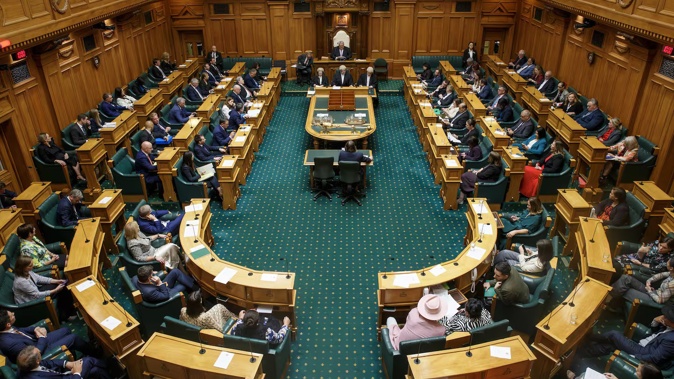
Prime Minister Christopher Luxon’s salary will rise in tranches by $50,000 from his previous $471,000 to $520,000 in mid-2026 while Opposition leader Chris Hipkins gets a much more modest $13,000 increase over the same period under the Remuneration Authority’s review of MPs’ salaries.
However Luxon says he does not need the increase and intends to donate it to charity.
For most MPs, the decision delivers a backdated 2.8 per cent increase from October 2023, a 2.9 per cent increase from July 1 this year, a further 2.4 per increase in July 2025, and a 2 per cent increase in July 2026. They are the first increases to MPs’ salaries since 2017.
Luxon’s will lift immediately to $484,000, backdated to the October election. It then rises to $498,300 in July this year before tipping over the $500,000 mark in July 2025 when he will get $510,300. Another $10,000 rise takes him to $520,000 in 2026.
Cabinet ministers’ pay will jump by almost $30,000 over the three-year period from $296,000 to $327,100 in 2026, while ministers outside Cabinet go from $249,839 to $276,000.
Backbench salaries will go up by about $20,000 from $163,961 to $181,200 in July 2026.
Deputy Prime Minister Winston Peters’ salary goes up by about $10,000 immediately from $334,100 to $344,100 - and that salary rises to $369,800 by 2026, by which point Act leader David Seymour will have the job.
However, Hipkins gets a more modest increase of $13,000 over three years, taking him from $296,000 previously to $309,000 in 2026.
The Opposition leader was previously paid the same as Cabinet ministers – but the Remuneration Authority’s decision will result in Cabinet ministers being paid more than Hipkins.

PM Christoper Luxon will get $50,000 in rolling pay hikes by 2026. Photo / Dean Purcell
In a statement this afternoon, a spokesperson for Luxon said: ”The Remuneration Authority runs an independent process to set MPs’ pay.”The Prime Minister has indicated he does not want or need an increase so any increase he received would be donated to charity.”
Remuneration Authority chair Geoff Summers said the smaller increases for the Leader of the Opposition recognised the greater role of small parties in Opposition under MMP.
In other changes, the Authority had introduced salary bands for co-leaders and adjusted the way smaller party leaders and whips were paid to simplify the system.
The Remuneration Authority has also changed the allowance MPs get to help pay for expenses such as meals while travelling and koha. For the Prime Minister, that goes from $22,606 to $25,600 by 2026, while all other members of Parliament will go from $16,980 to $19,300.
Under the law, MPs’ pay is set by the politically independent Remuneration Authority and reassessed after every election.
While the Authority must give MPs a chance to have their say, Luxon has repeatedly refused to comment on what he thought should happen, saying he believed it was best left in the hands of the independent authority.
Under its legislation, the Authority is required to set MPs’ pay for the whole Parliamentary term in advance.
That must be done in four stages: from election day (October 15, 2023) to June 30, 2024; from July 1, 2024 to June 30, 2025, from July 1, 2025 to June 30, 2026, and then from July 1, 2026 until the next election day.
The Remuneration Authority began its review of salaries and allowances in November, after the election. A lengthy report accompanying the salary changes said it was the first full review of salaries in more than 20 years.
The Authority had looked at the salaries of the Prime Minister, Ministers and MPs compared to their counterparts in other countries, as well as approximate private sector equivalents - such as corporate CEOs. It concluded that New Zealand MPs’ salaries were less than salaries in most comparable roles.
The Authority described it as a “greenfields review” rather than simply deciding whether to increase pay, and by how much.
The Authority has to weigh up factors including how MPs’ pay compares with comparable positions, the wider economic situation and the burden on taxpayers.
MPs’ pay has effectively been frozen since 2017, other than a brief period during Covid-19 over which MPs took a temporary pay cut.
In 2018, then-Prime Minister Jacinda Ardern instituted a pay freeze for all MPs after the authority recommended a 3 per cent pay raise. Ardern said the increase was “out of kilter” with the wage increases others were getting.
The recommendation came at time of widespread teacher and nurses strikes across the country. The Remuneration Authority subsequently decided to hold it at the same level through the 2020 - 2023 term, largely because of Covid-19.
Claire Trevett is the NZ Herald’s political editor, based at Parliament in Wellington. She started at the NZ Herald in 2003 and joined the Press Gallery team in 2007. She is a life member of the Parliamentary Press Gallery.
This article was originally published on the NZ Herald here.
Take your Radio, Podcasts and Music with you








